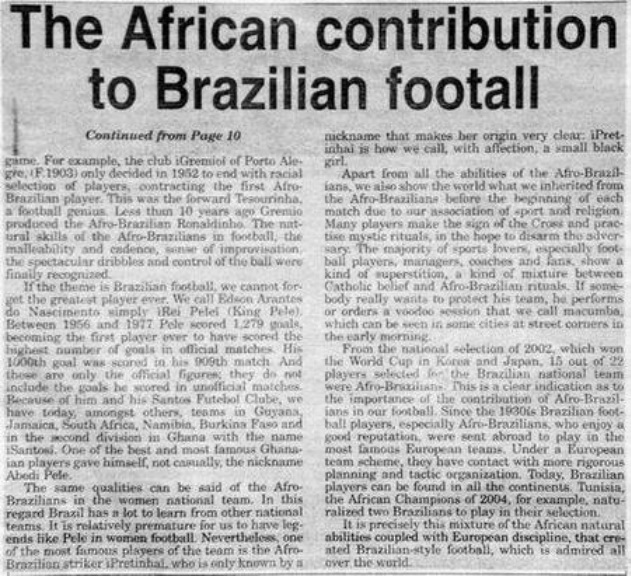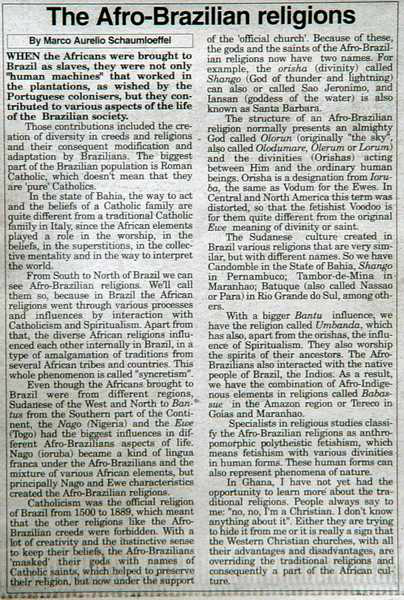SCHAUMLOEFFEL, Marco Aurelio. The African Contribution to Brazilian Football. Graphic Sports – Weekend Edition, Accra, v. 2289, p. 10 – 11, 08 abr. 2005.
The African contribution to Brazilian Football
To think of Brazilian football without African contribution is virtually impossible. We are the only nation that participated in all the World Championships ever organized and are five times World Champions (1958, 1962, 1970, 1994 and 2002). One of the biggest factors for this feat is undoubtedly the African characteristics brought into our way of playing this game.
Football was introduced in Brazil by the Brazilian Charles Miller in 1894. He was the son of an English couple, studied in England and played in the team of Southampton as a striker. When he returned to Brazil, he brought two balls and could hardly imagine what a sensation he would cause in our country. The first official team in Brazil was Sport Club Rio Grande, founded in 1900 in the South of Brazil by guys of German, English, Portuguese and Brazilian ascendancy. Soon after that all the other, today famous, clubs like Sao Paulo, Corinthians, Flamengo, Fluminense, Gremio, Santos and Palmeiras were founded.
Initially it was only played by people of the highest social standing, being considered a “noble” sport like golf, tennis or yachting. But soon people started to improvise the game with e. g. balls made of leather and stuffed with old paper or rags. Any vacant lot, sand area, river bank or even in the middle of the street is an appropriate place to play an amateur match, that we call “pelada”. Pelada is for everybody who enjoys to play football, poor and rich, black and white. It is maybe the most democratic popular institution in the world. Apart from that, it is certainly the birthplace of the biggest new Brazilian football stars. Romario, Ronaldo and Ronaldinho Gaucho, just to cite a few, started their careers in the streets, before they could play in the largest football stadium in the world, the Estadio Maracana in Rio de Janeiro, which can hold a crowd of over 200,000.
Everyday I can see peladas in various parts of Accra, which I’m sure is pure fun and certainly also good grounding for new Ghanaian football talents.
Since football was considered a sport for “special” people in the early 1910’s, the Afro-Brazilians were initially not allowed to play in the clubs. But it was inevitable to notice their abilities for the game. Soon football worked as an emancipation instrument for poor black, mullato and white people. In 1923 the team of Vasco da Gama won the cup of Rio de Janeiro, with a team basically composed of Afro-Brazilians rejected by other clubs, causing the admiration of football fans. The club “Gremio” of Porto Alegre, founded in 1903, e.g. only in 1952 decided to end with racial selection of players, contracting the first Afro-Brazilian player. It was the forward Tesourinha, a football genius (less than 10 years ago Gremio produced the Afro-Brazilian Ronaldinho). The natural skills of the Afro-Brazilians in football, the malleability and cadence, sense of improvisation, the spectacular dribbles and control of the ball were finally recognized.
If the theme is Brazilian football, we can not forget the ever greatest player. We call Mr. Edson Arantes do Nascimento simply “Rei Pele” (King Pele). Between 1956 and 1977 Pele scored 1,279 goals, becoming the player ever to have scored the biggest number of goals in official matches. His 1000th goal was scored in his 909th match. And these are only the official figures, without all the goals scored in unofficial matches, in which he took part, just to give an idea. Because of him and his Santos Futebol Clube, we have today, amongst others, teams in Guyana, Jamaica, South Africa, Namibia, Burkina Faso and in the second division in Ghana with the name “Santos”. One of the best and most famous Ghanaian players gave himself, not casually, the nickname Abedi Pele.
The same qualities can be said of the Afro-Brazilians in the women national team. In this modality Brazil has to learn a lot from other national teams. It is a relatively new modality, so that we can not have legends like Pele in women football, but one of the most famous players of the team is the Afro-Brazilian striker “Pretinha”, who is only known by her nickname which makes very clear her origin, for “Pretinha” is how we call, with affection, a small back girl.
Apart from all the abilities of the Afro-Brazilians, we also show the world what we inherited from the Afro-Brazilians before the beginning of each match due to our association of sport and religion. Many players make the sign of the Cross and practise mystic rituals, in the hope to disarm the adversary. The majority of sports lovers, especially football players, managers, coaches and fans, show a kind of superstition, a kind of mixture between Catholic belief and Afro-Brazilian rituals. If somebody really wants to protect his team, he performs or orders a voodoo session that we call macumba, which can be seen in some cities at street corners in the early morning.
From the national selection of 2002, which won the World Cup in Korea and Japan, 15 out of 22 players selected for the Brazilian national team were Afro-Brazilians, figures that show the importance of the contribution of Afro-Brazilians in our football. Since the 1930’s Brazilian football players, especially Afro-Brazilians, who enjoy a good reputation, were sent abroad, to play in the most famous European teams. Under a European team scheme, they have contact with more rigorous planning and tactic organization. Today, Brazilian players can be found in all the continents. Tunisia, the African Champion of 2004, for example, naturalized two Brazilians to play in their selection.
And it is just the mixture of the African abilities with the European discipline, the severe schemes, straight and without any creativity, that created the Brazilian football, admired all over the world. The best example of good results and profits of a sport globalisation is a Brazilian player with roots in Africa, who goes with all his creativity and innuendos to Europe to learn all about the boredom of planned everyday life in sports. The result, as we know, is superb.
P.S.: I used here conscious the term “football” instead of the strange word “soccer”. In Brazil we ignore the violent American football, and I prefer to stay with “football” (“futebol” in Portuguese) in its original meaning, the art that combines “foot” and “ball”. Since football has world dimensions and is not restricted to a few societies, I believe that we have the right to keep it with its original meaning.
Marco Aurelio Schaumloeffel
Brazilian Lecturer in Ghana




